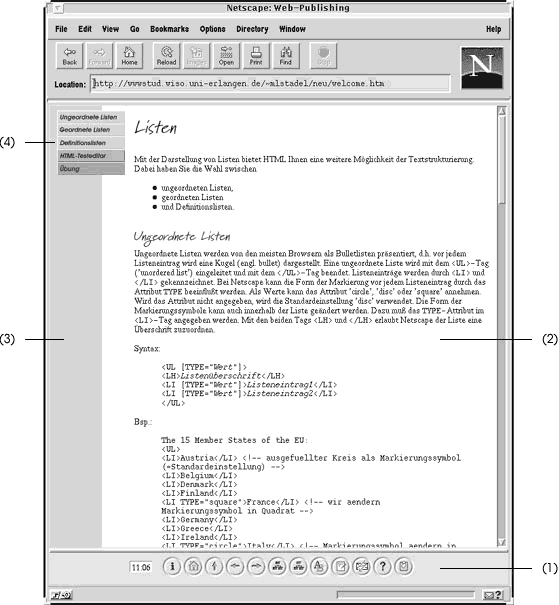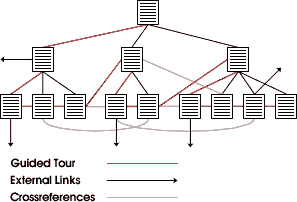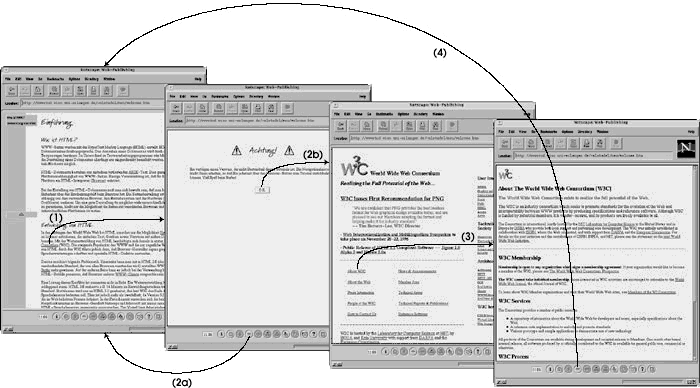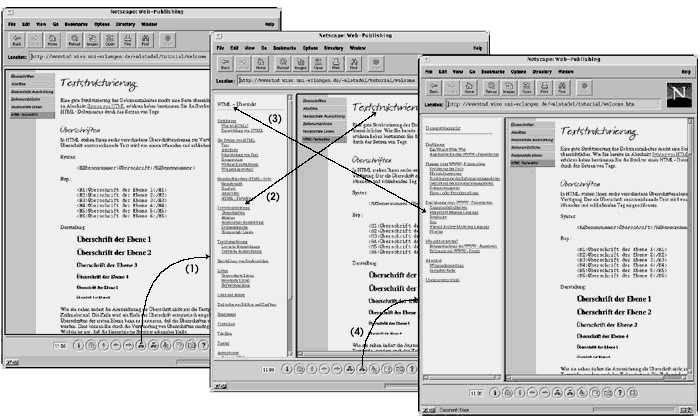Information Research, Vol. 3 No. 1, July 1997


Information Research, Vol. 3 No. 1, July 1997 | ||||
 |
 |
|||
At the University of Erlangen-Nuremberg, a project to create a "virtual campus", providing a network based learning experience is currently being run. Part of this undertaking is to provide students with multimedia WWW-based teachware packages on various subjects. This work aims at incorporating the highest possible level of support into the software itself - in particular through integrated navigational and orientation guides, with subsequent support through tutors, who are available through corresponding communication tools within the distributed environment of learning, teaching and co-operation.
Various forms of education and training, based on the classical Computer Based Training (CBT), have become well established within companies and in higher education. With regard to the flexibility in terms of time and location, as well as in terms of incurred cost, they are far superior to traditional forms of instruction. A relatively recent development which has not yet gained widespread acceptance is the use of the World Wide Web (WWW) as a basis and platform for distributed computer assisted teaching and learning. In addition to the advantages outlined with regard to classical CBT, the WWW offers the two advantages of world wide availablity as well as ease of promptly updating courses, but also adds many possibilities of collaborative learning. Using the Java programming language and the ever improving means of online presentation it has become possible to realize sophisticated WWW-based teachware packages which are comparable in terms of appearance and functionality to classical CBT applications created with dedicated authoring systems.
When developing this type of online courses a variety of WWW-specific mechanisms have to be taken into consideration. The WWW based hypertext concept, for instance, is particularly ambivalent within this context, as on the one hand it allows for a user determined exploration of learning materials, but on the other hand can create significant orientation problems for the user ("Lost in hyperspace" problem). This potential problem should be met with flexible navigational and orientation guides. Furthermore the learners within a distributed network based environment must not be left to study by themselves, as in the classical CBT situation. In addition to the support integrated into the teachware, it is crucial to offer the assistance of tutors through integrated media channels and to give the students the possibility of collaborative learning sessions with other participants. Finally when designing, preparing and presenting a WWW-based course, a few specific ergonomic and didactic requirements need to be met.
At the University of Erlangen-Nuremberg, which is spread out over an area of about 500 km2, a project to create a "virtual campus", providing a new type of network based learning experience is currently being run. Part of this undertaking is to create an open environment for teaching, learning and co-operation, which provides students with multimedia WWW-based teachware packages on various subjects. This work, which is being pursued as part of a teleteaching/telelearning project [6], attempts to take into consideration all the requirements outlined above. It aims at incorporating the highest possible level of support into the software itself - in particular through integrated navigational and orientation guides, with subsequent support through tutors, which are available through corresponding communication tools within the distributed environment of learning, teaching and co-operation.
The educational approach within the concepts presented here is influenced by the constructivistic philosophy of learning, which defines learning as an active, self-motivated, context and situation oriented social process [10]. While asynchronous on-demand forms of learning inherently require active and self motivated learning, the demand for context and situation oriented learning is satisfied by providing appropriate interaction modules. They permit the interactive discussion of authentic problems within the individual learning context, and hence offer a means for immediately applying the knowledge gained. For a HTML course for instance a JavaScript-based HTML test editor was developed, which allows the interactive creation and illustration of HTML documents.
In order to offer the learner interactive components as in standard progression tests, a building block was developed in Java, which provides a simple definition of free form and multiple choice questions and answers, that can be integrated into a WWW-based teachware package.
To create a social aspect, collaborative, guided learning, as well as multilateral communication and co-operation between learner and instructor are supported. Within this setting the increased activity demanded from the student is met on the instructor side through a role change from a presenter of information to a tutor, coach and moderator [9].
One of the main areas of application for WWW-based teachware packages is seen in supplementing conventional forms of teaching and learning. In this capacity they are particularly valuable in conveying basic knowledge. This could be realized by presenting individual university lectures or by integrating course materials from any number of courses into a reference type application. The teachware package hence acts as the basis for a conventional face-to-face lecture series, where the knowledge acquired is discussed in depth.
The multimedia WWW-based teachware packages introduced here draw upon a single unified screen design in all course modules, so that the user quickly becomes familiar with the learning environment and can develop a certain routine when dealing with the individual teachware application. This approach also counteracts the danger of inadvertently leaving the study package, for instance by following links to external sources of information on the WWW. A sudden change in screen design hence indicates to the user that he or she is no longer within the bounds of the original teachware application.
The goal when designing the graphical user interface (GUI) was to achieve a clear and structured, yet graphically appealing layout. Graphical overload, which is often observed in information services on the Internet, is avoided in order to reduce transfer time. The use of complex backgrounds is completely omitted, as these substantially curtail the readability of the document and lead to fatigue and drop in concentration when the reader is confronted with longer passages of text. High contrast colours are chosen for background and text, by default black type on a white background is used. Since the use of WWW applications is potentially platform independent, one needs to consider different display resolutions when developing teachware packages. This requirement is met by a layout, which is set up for working comfortably at resolutions of 640*480, 800*600, 1024*768 as well as 1152*900.
Figure 1 shows the standard screen design of the multimedia WWW-based teachware packages. The subdivision of the browser window into two separate frames is based on the layout suggested in [7], which calls for the actual information being displayed in the centre of the screen and being supported by core functionalities, such as navigational information and access information, in a persistent frame at the bottom of the screen. Consequently the presentation of course content and the activation of various other functions, which are discussed in chapter 2.3, in the top frame (information frame (2)) is governed by a control panel located in the bottom frame (control frame (1)).

The frame-based implementation guarantees that the control panel is always directly accessible. The problem of scrolling the navigation out of bounds, which often occurs in longer documents on the WWW with navigational areas at the top or bottom of the document, is hence avoided.
A colour coding of all different course modules simplifies the orientation within a teachware package. In practice this concept is implemented through a vertical colour bar on the left border of each document (3). The main course chapters of a teachware package are therefore allocated a unique colour, so that the learner can use this guide to always determine which part of the course he or she is currently viewing. In addition the colour coding serves as one building block within the extended orientation support (cf. chap. 3.4).
Longer course modules also provide jump-spots as an additional navigational aid, which are located in the side menu (4) and which ensure fast access to individual sections of the course module. The colour of the jump-spots corresponds to the vertical colour bar of that particular module. There are also other coloured jump-regions in the side menu, which provide particular interaction options and are labelled as interaction-spots. Their colour coding is consistent throughout the tutorial, for example red for standard progression tests in form of questions and answers or blue for context oriented interaction components.
At the end of each course module you find information about the author and the creation date.
The approach of the multimedia WWW-based teachware packages relies on a principle true for all computer assisted learning, that there must be a substantial difference in the electronic presentation of lecture material. The implementation must do away with the one-to-one conversion of paper documents, and must realize the potential for added value inherent in an interactive presentation, such as dialogue components and training modules.
With these requirements in mind the teachware packages are based on a building block system with a variety of reusable core components, which provide important functionalities and serve as a framework for the creation of multimedia WWW-based teachware packages on any topic. These functionalities are at the disposal of the user during the teachware session through the various buttons within the control panel introduced in chapter 2.2 (see figure 2). Depending on the context these buttons are dynamically deactivated or made available.

The graphical design of the control panel, implemented in Java, operates as one intuitively would expect. When clicking a button the action is acknowledged through a clicking sound and a button down-state. Through this audio-visual feedback the user is reassured that his or her interaction has been accepted by the teachware module. Buttons that are dynamically deactivated, or which are unavailable in certain contexts, are presented to the user in a shaded state. A click on these buttons is neither accompanied by a clicking sound nor through any change in the button state. The function of each individual button is shown in the status line of the browser as the mouse moves over the clickable area. The navigational buttons for instance show the target course content as the mouse moves over the hotspots. The following section briefly outlines the optional functionalities that can be activated through the control panel.
The multimedia WWW-based teachware packages are implemented entirely in HTML, Java, JavaScript and WWW-compatible media formats, with no CGI processes taking place. This provides the means for online use on the Internet and Intranet but also allows for offline use via CD-ROM. The only prerequisite for the use of the teachware packages is a Java-compatible browser as a front end, with no additional applications or plug-ins to be installed and configured.
The teachware packages are based on a series of modular reusable components, which provide core functionalities and serve as a framework for developing WWW-based teachware packages with any type of content. In particular teaching material which is being produced within a teleteaching and telelearning context is frequently (re)used in WWW-based teachware packages. This teaching material consists of excerpts from lecture video recordings, corresponding digitized blackboard snapshots and overhead transparencies, as well as of contents from multimedia presentations, electronic lecture notes, excerpts from the course textbooks, exercises etc. In addition, computer animation, textual, visual and audio components are added and external supplementary WWW resources for an online use are linked. The integration of these components, such as navigational guides, or a quiz applet as an interaction module for progression testing, does not require any changes Java or JavaScript program code.
The respective course author's tasks only include the subdivision of available electronic learning materials into suitable course modules and the integration of the materials into HTML documents, as well as linking the contents of the course to the supporting components outlined above, taking into account their specific advantages (i. e. navigational guidance, possibility of annotation, progression tests etc.) within the respective teachware package.
Hypertext systems such as the WWW are based on the idea of subdividing the bulk of information on one type of subject into individual information units (knots) which are interconnected to yield a networked type of structure. Within this arrangement the user can freely explore the information surrounding a certain subject, where the degree of freedom of navigation depends on the organisation of the hypertext. Building on this concept, unstructured hypertext allows for a flexible exploration of the information within. Hypertext which is structured hierarchically, linear or in matrix form curtails this freedom of navigation, yet offers the means for an unaccustomed user of keeping a good sense of perspective.
The advantages inherent in a user determined exploration of course content are compromised by significant orientation problems on behalf of the learner. These occur when the user has difficulties while determining his or her exact position within the information presented, or is not able to locate certain information. These problems are often linked with difficulties in visualising the overall structure of the hypertext.
Besides the latent danger of disorientation, hypertext systems are often associated with problems of cognitive overload. The latter results from the fact that the learner must utilize additional mental capacity to realize the available possibilities of navigation, which information has already been dealt with and which information remains subject to exploration etc. [11]. When realizing WWW-based teachware packages the design and implementation of flexible navigational and orientation guides are crucial. On the one hand the learner should always be able to determine his or her current position within the presented information (orientation capability). On the other hand, the user should at any time recognize the available navigational options, and be able to easily locate information, which is known to be part of the teachware package (navigation capability).
With an unstructured presentation of information one can rarely get a perspective of the subject area, which hinders the search for individual information and orientation within the available material. When creating WWW-based teachware packages, the course materials are generally structured in a hierarchical manner. In order to facilitate the navigation for unaccustomed hypertext-users and to present the individual course modules which are based on each other way, the hierarchical structure is supplemented by a linear guided tour. This path then encompasses all the electronic chapters of a teachware package.
The potential inherent in the hypertext concept of the WWW is utilized by cross linking information within the package and by linking to external resources on the Internet. Figure 3 shows the basic structure of a WWW-based teachware package.

One could envisage an extension of the chosen structure to incorporate additional guided tours, which would for instance be able to accommodate the different levels of knowledge among users. Furthermore a flexible generation of paths is conceivable, which would adapt to the knowledge level of the learner in the course of the teachware use. To achieve this one could either predefine a diverging system of learning paths, or one could generate an individual learning path „on the fly" using knowledge based methods [8]. With the approach chosen for multimedia WWW-based teachware packages, a single linear guided tour is thought to be sufficient, as different knowledge levels are accommodated by optionally skipping one chapter and through the efficient and simple mechanisms of locating information.
The definition of a guided tour as the basis of navigational support within WWW-based teachware packages differs from related research work as described in [2], [4] and [5]. In particular the complete absence of CGI techniques is a new approach, hence removing the need for any client-server interaction. The CGI interactions are replaced by a client side Java/JavaScript implementation which not only offers better performance, but also allows for the offline operation of the teachware package using file protocol interactions.
In principle the course content may be experienced in two ways. First, through unstructured exploration, looking at the table of contents, overview pages and by following links to more information within the teachware package (user determined presentation). Second, by using the next button to follow the predefined guided tour step by step (system determined presentation). In the context of this second approach the previous button allows the user to go back one step on the guided tour, whereas the up button brings the user to the root of the hierarchically preceding course module. If the user initially decides to use the system determined presentation, but leaves the predefined path, for instance to follow links and cross-references to supplementary external resources on the WWW (composite type presentation), he or she can always directly return to the last viewed chapter of the online course by using the previous button.
Figure 4 shows a schematic representation of the navigation guides within a composite type presentation: If the user selects a link to an external source of information on the WWW, the learner is alerted that he or she is about to leave the guided tour of the teachware package (1). At this point the user has the option to return to the guided tour by pressing the previous button (2a), or to follow the external link (2b). If the learner at this point chooses the latter option, the information is loaded from the WWW into the information frame without relinquishing the functionality of the control panel which is preserved in the adjacent control frame. Within the external sources of information on the WWW the user can follow any other links (3). By using the previous button he or she can always directly return to the last chapter within the guided tour of the teachware package (4), without having to use browser specific aides, such as multiple clicks on the "back" button.

This functionality, referred to as guided tour support, is available in all situations, open to a departure from the predetermined path, i. e., when looking up terms in the glossary or when consulting the online manual.
To avoid the problem of disorientation within the course material, WWW-based teachware packages are structured hierarchically, with colour coded main chapters. A colour bar, displayed on the left side of each page, indicates the association of each unit with a certain chapter (cf. chap. 2.2). Since despite all these efforts a disorientation of the user cannot be completely ruled out, a supplementary orientation concept was implemented which is accessible via two buttons in the control panel. Figure 5 demonstrates the possible course of action taken by the user to determine the current location.

A schematic yet detailed view of the current chapter is shown in a separate frame via the chapter-content button (1). Below the entries the headline of the current unit within the chapter is displayed (2). At the top of the chapter content listing the name of the current chapter is noted. This in term corresponds to an entry in the schematic view of the entire course structure (3), which is accessible by clicking on the overall-content button (4). Based on these interconnections the structure of all the information that is available immediately becomes transparent, thus allowing the user to always determine his exact position. By using frame technology this approach does not require the user to leave the guided tour.
An evaluation of the introduced approach to multimedia WWW-based teachware packages in an open environment of teaching, learning and co-operation is taking place at the University of Erlangen-Nuremberg during the 1997 summer semester. The goal is to examine the integration of a WWW-based course into the regular curriculum. In order to achieve this, 60 students will be given access to a teachware package as part of a business information systems seminar, containing various multimedia teaching materials from different lectures at the University of Erlangen-Nuremberg. This teachware package will be employed to impart basic knowledge in the field of Internet and WWW related technologies. The participants will have three weeks to interact with the teachware package at their individual pace and without being restricted to a certain location, to gain the fundamental knowledge in the subject being dealt with. During this period of time the participants can make use of the bulletin board system outlined above, where the tutor acts as a coach moderating the entries on the board. The tutor and the development team of the teachware package are always available for questions regarding content, technology and ergonomy, through asynchronous communication tools and also via synchronous videoconferencing and groupware tools during certain office hours. In this scenario the teachware package acts as the basis for a conventional face-to-face lecture series, where the knowledge acquired is discussed in depth. In addition, the application of this knowledge in a business related context is dealt with.
The positive feedback to this prototype framework for multimedia WWW-based teachware packages - award winning in this year's software competition "Multimedia Transfer '97" of the German Academic Software Co-operation - encourages an extended evaluation beyond the boundaries of our university. An evaluation of the package is planned at several German and Austrian universities and colleges, as well as in companies and in the area of teacher training. The interest shown by external institutions and a group of experts in the field of higher education, suggests that multimedia WWW-based teachware packages may not only present a suitable medium for WWW-based learning in higher education, but also a means for knowledge transfer between universities and external interest groups. Areas of application are conceivable within companies, in research institutes, in private and public educational institutions as well as for private individuals, who are required to face the challenge of lifelong learning.
Furthermore the development of additional reusable components for multimedia WWW-based teachware packages is planned. Particular emphasis will be placed on the development of Java-based interactive components as well as on an extended navigation support with graphical overviews and an adaptive approach.
Finally the reusability of the WWW-based course modules and content is considered a very important issue. The aim is to create a set of tools, which allows the tutor to easily combine teaching materials already present on the WWW, forming individual courses with any type of content.
[1] Euler, D., "Didaktik des computerunterstuetzten Lernens - Praktische Gestaltung und theoretische Grundlagen", Nuremberg 1992, p. 19.
[2] Goldberg, M. W., Salari, S., Swoboda, P., "World Wide Web - Course Tool: An Environment for Building WWW-based Courses", in: Computer Networks and ISDN Systems, 28 (7-11) 1996, pp. 1219-1231.
[3] Graesel, C., Bruhn, J., Mandl, H., Fischer, F., "Lernen mit Computernetzen aus konstruktivistischer Perspektive", Research Paper No. 73, Dpt. of Empirical Pedagogics and Pedagogical Psychology, Ludwig-Maximilians-University of Munich, Munich 1996, pp. 17-20.
[4] Hauck, F. J., "Supporting Hierachical Guided Tours in the World Wide Web", in: Computer Networks and ISDN Systems, 28 (7-11) 1996, pp. 1233-1242.
[5] Kutschera, P., "Combining Database Technology with the World Wide Web for Tele-teaching Environments", in: Swiridow, A. P., Widmayer, P., Oberhoff, W.-D., Unger, H. (Eds.), "New Media for Education and Training in Computer Science", Infix, St. Augustin 1996, pp. 99-108.
[6] Langenbach, C., Grebner, R., Bodendorf, F., "Multimedia-unterstuetzte Dezentralisierung interdisziplinaerer Lehre", Research Paper Information Systems II, No. 05/1997, Friedrich-Alexander-University of Erlangen-Nuremberg, Nuremberg 1997 (forthcoming).
[7] Macaulay, L., "Human-Computer Interface for Software Designers", London 1995, p. 74.
[8] Eklund, J., "Adaptive Hypertext & Hypermedia", http://www.education.uts.edu.au/ projects/ah/, May 27th, 1997.
[9] Reimann, P., Schult, Th., "Schneller schlauer - Bildung im Multimedia-Zeitalter", in: c't - magazine for computer techniques, 9 (1996), p. 186.
[10] Reinmann-Rothmeier, G., Mandl, H., "Multimediale Lernumgebungen", in: Geissler, K. A., v. Landsberg, G., Reinartz, M. (Hrsg.), „Handbuch Personalentwicklung und Training", Deutscher Wirtschaftsdienst, Cologne 1997 (forthcoming).
[11] Tergan, S., "Hypertext/Hypermedia - Konzeption, Lernmoeglichkeiten, Lernprobleme", Tuebingen 1995, p. 12.
How to cite this paper:
Langenbach, Christian & Bodendorf, Freimut (1997) "Learner support in a distributed learning environment:the use of WWW-based teachware packages" Information Research, 3(1) Available at: http://informationr.net/ir/3-1/paper31.html
© the author, 1997. Updated 7th August 1999
Contents |
|
Home |